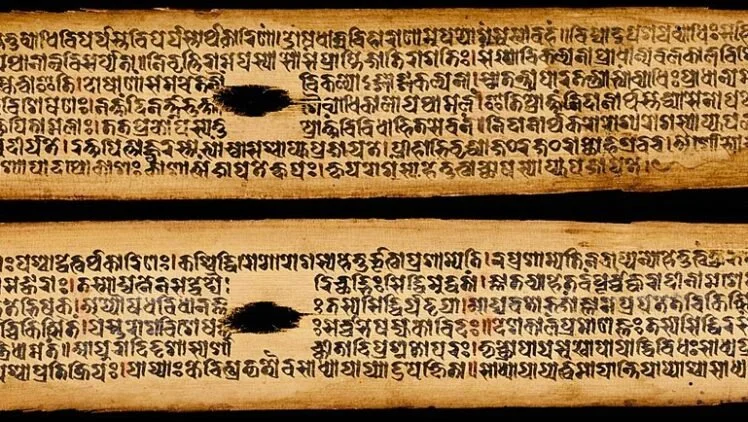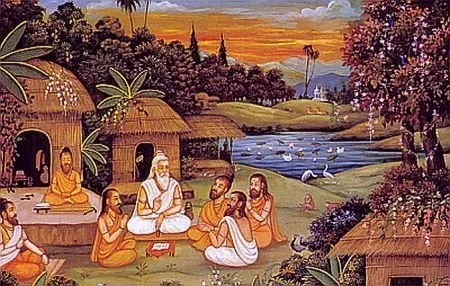What is Āyurveda?
The term Āyurveda is composed of two Sanskrit words; Āyuh, meaning life, and Veda, meaning science or knowledge. Thus Āyurveda means ‘the science of life’.
As written in this sūtra by Caraka, Āyurveda describes:
- The substances and activities useful to the preservation of life
- The substances and activities counteractive to life
- States of balance (health) and imbalance (disease)
- Ways of measuring the quality and quantity of life
- The definition of life itself
In its written form, Āyurveda has existed for over 3000 years, with the earliest artifacts found being Sanskrit sūtras painted onto dried palm leaves, preserved to this day. It is likely that even before this, Āyurveda was being practiced and taught as an oral tradition.
Āyurveda is an upaveda, or ancillary text inspired by the Vedas, having its roots in Atharva veda. The Vedas contain a vast trove of information on life and spiritual practices that form the foundation of vedic knowledge, underpinning the spiritual and lifestyle practices of ancient India.
To this day, Āyurveda continues to be taught and practiced in India, in traditional apprenticeship settings, passed down through families of vaidyas as well as in modernized hospital and university settings. Approximately 70% of India’s population depends on Ayurvedic medicine (Pubmed, 2007). In the past century, Āyurveda has spread to almost all corners of the world as well as experiencing a resurgence in its native India.
Origins of Āyurveda
Unlike modern medicine, which relies on ever-evolving evidence and research, Āyurveda was not created by humankind. In fact, it is written in the classical texts of Āyurveda that the science of life has no beginning and was ‘remembered’ by Brahman, the pure consciousness that created the world instead of being created at a particular point in time.
That this manual of living came about in sync with creation and life itself has a profound significance. Firstly, it highlights Āyurveda’s timelessness, that it can be applied to life at all times. Secondly, the esoteric meaning of this sūtra emphasizes how Āyurveda can descend within an individual through pure consciousness into their mind, senses, agnis, motor senses etc.
Many students of Āyurveda remark that learning these timeless and universal principles feels more like remembering than taking on completely new information, perhaps because its model of reality is so pragmatic, elemental and close to the natural world as well as being one with the consciousness within each of us.
The language of Āyurveda
Enlightened masters in ancient times were able to capture the essence of Āyurveda in the language of ancient India, Sanskrit. These sages compiled books of this knowledge in the form of sūtras.
Sūtra, meaning ‘thread’, is where we get the english word ‘suture’. They are short verses or aphorisms that contain profound, condensed, timeless and universal information. They are used by all knowledge systems including the Vedas and Yogic texts, thereby weaving together one huge body of knowledge.
Āyurveda has since these times and to this day been recited by students and vaidyas, in the form of these sūtras, which are memorable owing to their concise and often rhythmic form; due to their metre (chanda) and phonetics (siksha).
The principal texts where these Āyurvedic sūtras are found are known as the brhat trayi (great three); the Charaka samhita, Sushruta samhita and Ashtanga Hrdayam which together contain vast numbers of scriptural threads on the etiology, symptomatolgy and treatment of disease.
As we approach this science, we may lack the direct perception necessary to see the qualities of substances, symptoms of disease and appropriate treatment clearly. Chanting the Āyurvedic sūtras not only creates understanding through learning their content, but simultaneously through the vibration of the Sanskrit words, order is instilled in the mind and deeper intuition and perception is awakened.
Definition of Life
Since Āyurveda is the science of life, it is important to look to the Vedic definition of life itself, to fully understand what Āyurveda is. According to Caraka, the author of one of the great three texts of Āyurveda, life is what happens when mind, body and soul come together. The study of this communion of mind, body and soul and the healing of imbalances of mind, body and soul is the purpose of Āyurveda.





